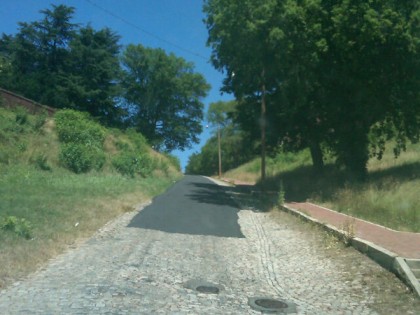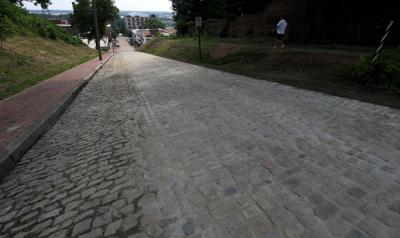My write-up of Dave Eggers’ The Parade is up at The Millions. Read it here.
The plot of the book is deceptively simple: a guy is paving a road. The roadbed is prepared; all the protagonist has to do is drive a machine that lays down the asphalt and even paints the yellow lines. He has an assistant to make sure no obstacles lie ahead, but the paving itself is a one-man show. I did some research on-line to see if the machine is for real or if Eggers made it up. In the process, I enjoyed watching several videos of road paving. This was one of my favorites.
Amazing as the machines in the video are, clearly putting asphalt on a roadbed is not a one-man operation. Eggers’ marvelous road paving machine sets his story in the future. (Needless to say, despite the machine, the paving project does not quite go as smoothly as the protagonist would like.)
Asphalt has been widely used for pavement for over a century. When introduced it was seen by many as an improvement over cobblestones or Belgian block, woodblock, and brick, not to mention dirt and gravel. It’s smoother and quieter, easier on horses’ hooves, and easier to clean. Cleanliness wasn’t only an aesthetic concern. In the age of the horse, manure dust caused serious respiratory problems. Asphalt’s durability gave it victory over its chief rivals, macadam (crushed stone) and tarmac (crushed blast furnace slag, tar, pitch, portland cement and resin).
As laid on roadbeds, asphalt is a semi-solid form of petroleum mixed with aggregate, such as particles of stone, sand, recycled cement, slag and gravel. Asphalt (to be exact, asphalt cement) has proven itself to be a superior road surface, but it isn’t trouble free.
The protagonist in The Parade praises the new surface he’s laying down as less toxic than old-style asphalt. He even gets on his hands and knees at one point to breathe in its oatmeal-like scent. Today’s asphalt is toxic, particularly in its molten state, affecting road workers, roofers, and those in hot-mix plants. According to OSHA: “Over a half-million workers are exposed to fumes from asphalt, a petroleum product used extensively in road paving, roofing, siding, and concrete work. When hot asphalt is applied in a molten state, it generates toxic fumes. Workers exposed to asphalt fumes are at risk of developing headaches, rashes, cough, and possibly cancer.”
Some lament, too, the by-gone beauty of stone-paved streets. Some cities have restored and preserved at least sections of the old streets. The pictures below show 23d Street, Richmond, VA, before and after restoration: patched with asphalt, and restored to its former glory.


Sources: Under Hoof, Foot and Tire, by Christopher Gray, NYTimes | OSHA | National Asphalt Pavement Association | Richmond Times-Dispatch
Pingback:Cobblestones, Granite block, and Road Pavement